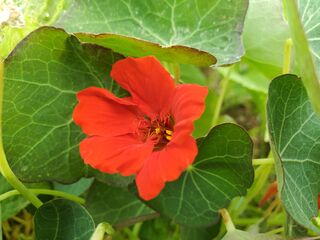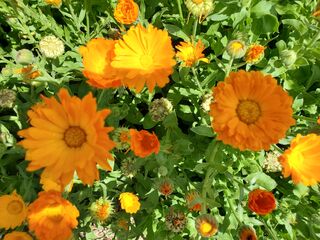

Nasturtium and calendula pack in antioxidants, vitamins, and minerals.
Key points
- Nasturtium flowers and leaves taste great and can be used in a variety of dishes.
- Calendula plant has been used as a medicinal herb for centuries.
- Use them sparingly in your dishes since in large quantities they may cause digestive problems.
Edible flowers taste great and look beautiful on your plate, especially on top of your favorite salad. Not all flowers are edible, and you can find complete lists, with pictures, on the Internet. Please only use flowers from your garden if you grow them organically — which means they aren’t exposed to pesticides or artificial fertilizers — or grow them in pots away from pollution. You can use flowers like nasturtiums or some begonias or flowers of culinary herbs such as violet flowers of sage, and some medicinal herbs such as beautiful and fragrant blue flowers of rosemary and petals of calendula. The flowers usually taste similar to the leaves, but some may be spicier, like rosemary flowers. Also, don’t use them in large quantities, since they may cause digestive problems. Use them sparingly in your dishes for great taste or as a garnish. Less is better.
In today’s post, I will concentrate on my favorite edible flowers: nasturtium and calendula. Please remember that what is good for your body is also good for your brain. Your brain does not work in isolation. The healthier your body, the better your brain will function.

Source: Barbara Koltuska-Haskin
Nasturtiums taste great and are packed with nutrients. Flowers of nasturtium come in many cheerful colors and contain vitamin C, which supports our immune system and might help fight fungi and viruses. They also contain vitamin B, iron, magnesium, phosphorus, calcium, zinc, and copper, and have antimicrobial and some anti-inflammatory properties. Nasturtium plants are also used in alternative medicine in combination with other medicinal plants. There is insufficient evidence in the literature for medicinal use, but we can still enjoy them in our summer dishes. They’re easy to grow and can reseed themselves, but since they’re frost-sensitive, you can only enjoy them outside up to the first frost. All parts of the nasturtium plant are edible. The flowers and leaves have a somewhat spicy flavor. They taste great in salads and look beautiful on top of salads. You can also put them into soups and smoothies with other flowers like lavender, squash blossoms, arugula flowers, borage flowers, and calendula petals.

Source: Barbara Koltuska-Haskin
Calendula flowers bloom in shades of yellow and orange. The leaves and petals of this plant are edible. This is a very versatile plant that has been used in dishes and as a medicinal herb for centuries. It is a powerful antioxidant that has strong anti-inflammatory, antibacterial, antiviral, and antifungal properties. It also helps with the digestive system and hydrates and nourishes skin. It contains Vitamin C and E, carotenoids and flavonoids (both are antioxidants), polysaccharides, and essential oils. Calendula is FDA-approved for use as a culinary spice and also as an ingredient in cosmetics and a wound treatment. It soothes internal wounds and burns. However, it may cause your pollen allergy to get worse. So, if you have a pollen allergy, talk to your health care professional before you use it. Calendula petals look great on the top of salads and add colors to other dishes. I use calendula petals in rice and grain dishes as well. Calendula plants are very easy to grow and will come back every spring. Also, chamomile flowers have been known for centuries to have anti-inflammatory and antianxiety properties. However, the flowers are quite bitter, so use them in your smoothies; you won’t taste the bitterness but will still get health benefits. Try some of the edible flowers in your kitchen and have fun with it.
Part of today’s post is from my book, How the Brain Works: A Guide to Understanding It Better and Keeping It Healthy.
This article was originally published on Pyschology Today. Copyright by Dr. Barbara Koltuska-Haskin.
 Barbara Koltuska-Haskin, Ph.D., is a neuropsychologist in private practice in Albuquerque, New Mexico with over 30 years of clinical experience, and the author of How My Brain Works: A Guide to Understanding It Better and Keeping It Healthy. Her book has won 2 International Book Awards and 3 National Book Awards.
Barbara Koltuska-Haskin, Ph.D., is a neuropsychologist in private practice in Albuquerque, New Mexico with over 30 years of clinical experience, and the author of How My Brain Works: A Guide to Understanding It Better and Keeping It Healthy. Her book has won 2 International Book Awards and 3 National Book Awards.








Comments
Post a Comment